AMSTERDAM - As I turn a corner off Rembrandt Square, I see six Grand Canal homes reflected in the Herengracht (Gentleman’s or Lord’s) Canal like giant dollhouses. Their distinctive facades instantly identify them as homes built for nobles — mayors and leading Dutch merchants — during Holland’s Golden Age, when Amsterdam was the capital of world commerce.
Each of the massive, doublewide homes has a name — De Wildt, Kemp, Hooft, Marot, Sautijn and Brentano — and a rich history; they were all built during the 17th and 18th centuries.
Few would disagree that this is the best collection of canal homes in all of Amsterdam and, thanks to an engineering miracle, they’ve been brought together to form the city’s best hotel — the Waldorf Astoria Amsterdam, a property the likes of which Amsterdam has never seen.
It took years of careful and painstaking planning to transform the UNESCO World Heritage protected homes into a luxury hotel and maintaining the dignity of these treasured properties was a daunting task, but one the architects employed by the world-renowned Waldorf Astoria chain have exceeded in every respect.
My arrival at the Waldorf Astoria Amsterdam — the Marot house serves as the main entrance — is a special experience because I’m instantly awed by the home’s elaborate vestibule and dramatic relief-filled staircase, two of the best-preserved examples of 17th-century Amsterdam architecture.
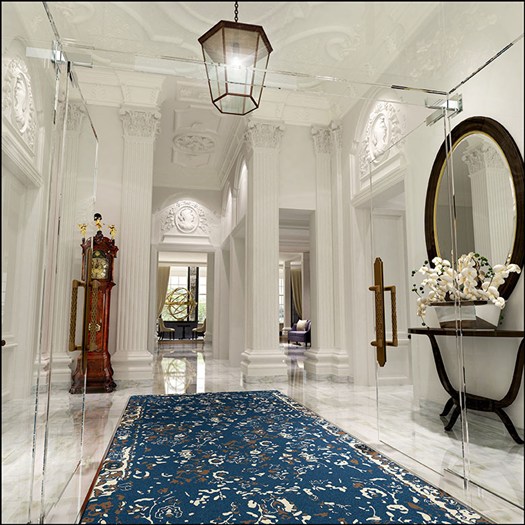
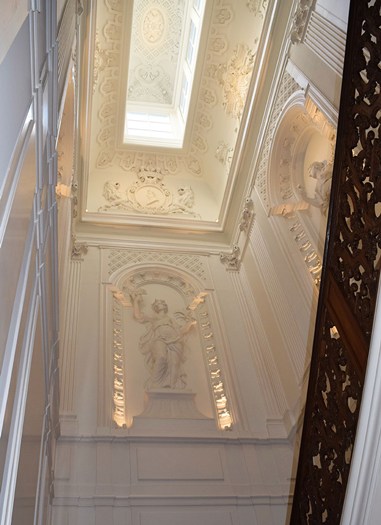
Left: The entrance to the Waldorf Astoria Amsterdam is like stepping back into the Golden Age of Holland. Right: The main staircase that former mayors of Amsterdam and their families once climbed retains its original brilliance.
Cornelis Becker, for whom the Marot House was built in 1665, would certainly be impressed with the “renovations” the Waldorf Astoria family has made, like:
• Creating 93 luxury state-of-the-art rooms and suites that qualify as the best in a city renowned for its upscale accommodation.
• Adding a 2-star Michelin restaurant called Librije’s Zusje Amsterdam.
• Introducing a fabulous Guerlain Spa to the city.
• And turning the homes’ tranquil inner gardens into a peaceful retreat for guests.
While staying true to its canal home roots on the outside, inside the hotel reflects a modern ambience that few other historic hotels in Europe can match. The carefully sourced furnishings, textured wall coverings and museum-worthy Dutch paintings blend in beautifully with the state-of-the-art bathrooms, the finest linens and every electronic and Wi-Fi convenience demanded by today’s plugged-in traveller.
The blending of the six homes into one great hotel has created some interesting passageways, where movie stars or high-powered guests can easily be hidden from public view if they so wish.
The Waldorf’s trademark service level is exceeded in its Amsterdam hotel because no one makes you feel more welcome than the people of Holland.
The entrance quickly drifts off to the Bel Etage, where the elegantly decorated Peacock Alley lounge serves as the gathering place for guests and the important people of Amsterdam. The lounge is wrapped in flowing drapery, hand-blown glass and classic furniture, with a Waldorf Armillary Sphere, which pays tribute to the properties’ links to “sail, trade and time,” taking centre stage. From the lounge guests get an elevated view of the lovely gardens where in spring over 5,800 tulips come to life.
Just off the Bel Etage is the impressive Maurer Room, a leftover from the Marot House’s earliest days, which is a great example of Italian design. The elegant room is in great demand for meetings and private dinners.
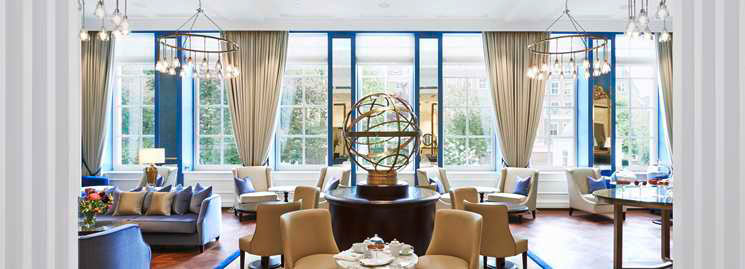
Above: The lobby area is then place to be seen in Amsterdam these days.
My room, which overlooks the Herengracht Canal, is breathtaking and comes wrapped in textured wall coverings that are highlighted by the natural light pouring through the floor to ceiling windows. The furnishings are covered in exquisite fabrics and soft textures prevail throughout. The Waldorf is most proud that each room displays its own individual character but I can’t imagine any of the other rooms matching mine for charm and elegance.
No hotel in Amsterdam, or the rest of Europe for that matter, can match the Waldorf Astoria Amsterdam for its dining options, especially the gastronomic experience offered at the decorated Librije’s Zusje.
In just seven short months after it’s opening, Librije’s Zusje Amsterdam was awarded 2 Michelin stars, and after eating there people wonder why it’s not been given a third.
The Waldorf Astoria Amsterdam entered into an exclusive partnership with noted restaurateurs Jonnie and Thérése Boer, owners of the acclaimed 3 Michelin star restaurant De Librije in Zwolle, Netherlands, to create Librije’s Zusje Amsterdam. They then convinced super star Chef Sidney Schutte, former chef at De Librije, to return from Asia to head up the kitchen at Librije’s Zusje.
The result of that collaboration has been nothing less than astonishing — never before has a Dutch restaurant earned such high acclaim in such a short time.
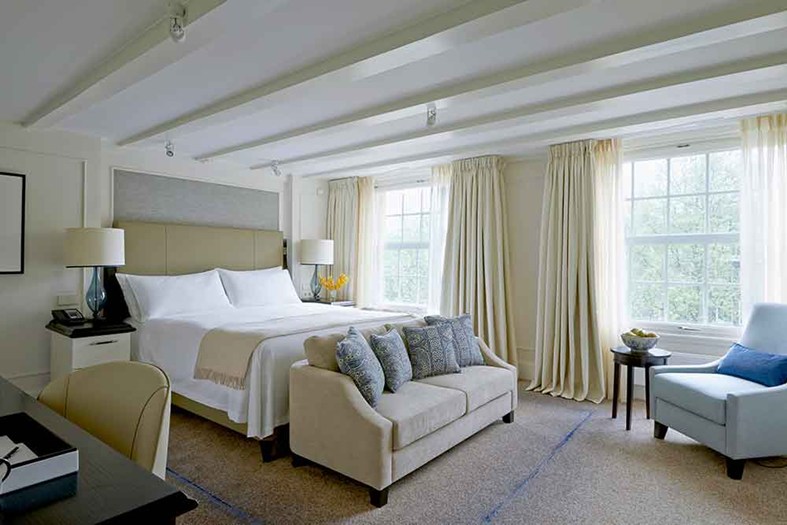
Above: The rooms are lavish and chic and offer brilliant views of the Gentlemans Canal or the lovely garden.
Needless to say, getting a table at Librije’s Zusje Amsterdam is like getting an audience with the Dutch king and so not to disappoint guests, Waldrof Astoria Amsterdam created a dining option that is almost the equal of Librije’s Zusje Amsterdam. Welcome to the Goldfinch Brasserie.
Located adjacent to the lovely garden and Librije’s Zusje Amsterdam, Goldfinch offers diners a Michelin star experience without the Michelin star price. Schutte oversees the menu at Goldfinch, as well, and dishes for the Brasserie are prepared in the same kitchen that services Librije’s Zusje Amsterdam. The name Goldfinch, by the way, was inspired by a painting by Dutch master Carel Fabritius (circa 17th century) of the bird of the same name.
The Crispy Suckling Pork — lacquered with clove honey and accompanied by sauerkraut and potato puree — I order is an orgasmic experience of which my taste buds have rarely experienced.
If you think the restaurants at Waldorf Astoria Amsterdam are fabulous, wait until you see the Guerlain Spa facility the property features. There’s only one problem with this spa — there’s just three treatment rooms and the demand is high, so book treatments well in advance of your stay so you won’t be disappointed.
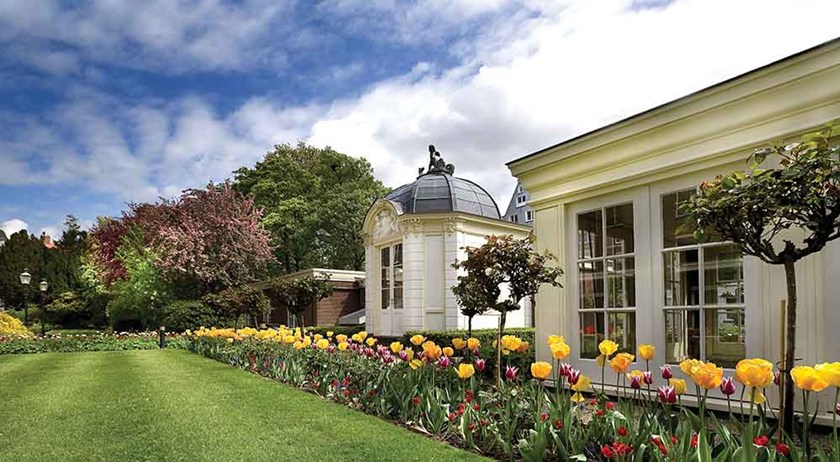
Above: The garden at the Waldorf Astoria Amsterdam is one of the most tranquil places in the city and in spring 5,000 tulips are on display.
This is a spa sanctuary like none other and its position on the garden level makes the experience even more tranquil and magical. Guests are taken on a trip through time to reach the Guerlain facility, passing through the hotel’s historic rooms filled with lovely sculptures and fascinating paintings. The tranquil walk gets them into a relaxed mood even before they meet their master therapist.
The Guerlian Spa offers some leading-edge treatments and afterwards guests can retire to the relaxation area overlooking the garden, or take a swim in the hotel’s incredible indoor pool.
Overall, the Waldorf Astoria Amsterdam is an indulgence that every traveller should splurge on because this, for our money, is the best overall hotel experience — restaurants, spa, rooms, service — anywhere in Europe.
Information
What sets most of these homes apart from other canal homes in Amsterdam is they have a double staircase entrance so the occupants didn’t have to go through the basement — a common occurrence in canal homes — to reach the living quarters. Here's a rundown on the homes used to make the Waldorf Astoria Amsterdam: Brentano: It was bought as a family home in 1753 by Josephus Brentano, a Dutch merchant of Italian origin. / Sautijn: This house was built for Mayor Willem Sautijn in 1672. / Marot: This house — it serves as the entrance to the Waldorf Astoria — was built in 1665 for the Backer family but many other prominent Amsterdam families also lived here. / Hooft: The house was built in 1665 for Hendrick Hooft, a scion of a very important patrician family. His father, Henrick Hooft was also Mayor of Amsterdam. / Kemp: In 1665 Joost Kemp, Lord of Kerkwijk, had this house built from sandstone, a luxury material that was imported from Germany. / De Wildt: Hendrick Hooft also had this home built in 1665. / The Waldorf Astoria has opened many new properties around the world and I must say I’m most impressed with their Amsterdam hotel as well as the one they’ve built in Beijing. Waldorf boasts 15 hotels and resorts in the Americas, five in Europe, three in the Middle East and three in the Asia Pacific region. To learn more about Waldorf Astoria properties worldwide, go to www.waldorfastoria.com / KLM is the best way to get to Amsterdam from Canada. The Dutch carrier offers flights from Toronto, Montreal, Vancouver, Calgary and now Edmonton. Go to www.klm.com/canada for fares and flight details. / For tourist information on Amsterdam, go to www.iamsterdam.com / For Holland, including Amsterdam, go to www.holland.com